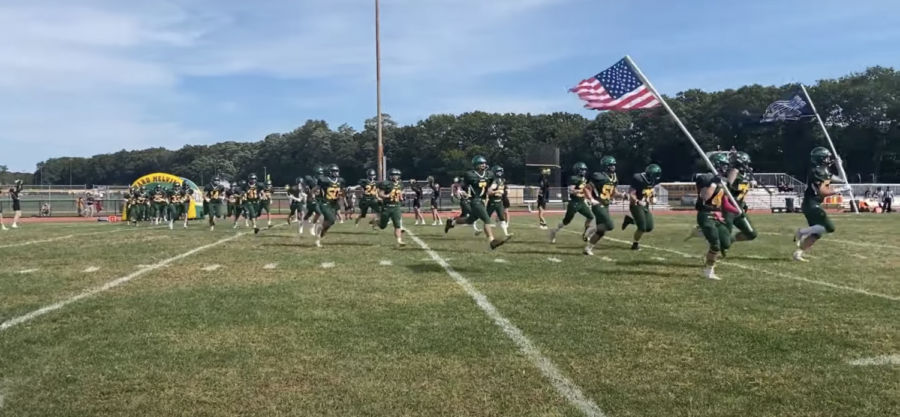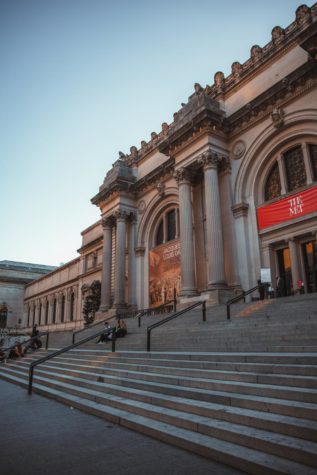Nobody Likes Cheering for the Football Team (and Other Homecoming Observations)
October 5, 2021
According to conventional wisdom, homecoming began during last Friday’s pep rally, which was an event that had a somewhat expected lack of pep and a disturbing number of people in Elmo costumes (just one). I, however, would argue that it began a few days earlier, when the Ward Melville Student Government Instagram account posted their dress code for Saturday’s homecoming dance. The now-deleted post read something along the lines of “boys should wear button-down shirts and nice pants, and girls should wear dresses or skirts.” It was under this post that the @wmhsbarstool account commented something to the impression of “wear whatever you want,” albeit with a more encouraging tone. Then, allegedly, the student government blocked the Barstool account. This sent the Instagrams of more progressively-minded students into a flurry, criticizing the Student Government.
This was the moment that got Ward Melville actually talking about homecoming. At least in the circles I’m in, which, granted, do not include football players and cheerleaders, for whom homecoming is a truly significant event.
Other than that slightly amusing fiasco, there wasn’t much worth noting about the spirit week leading up to homecoming. The most popular theme was, naturally, country day, because, in the absence of a regional identity (which is inherent in suburbia), Ward Melville students like to pretend that they are from the country. Or, at least, their cartoon idea of it: flannels, jean shorts, and cowboy hats. Carrie Underwood music optional.
The aforementioned pep rally arrived with mild excitement, mostly rooted in the opportunity to miss an hour of class. At 12:40 pm, the exodus began, as masses of students made the journey from the back doors to the football field, accompanied by speakers playing “Another One Bites the Dust” at volumes that are probably unsafe for human ears. The rest of the rally consisted of a marching band performance, and an awkward ten minutes where every sports team ran through an inflatable tunnel. Other notable moments include the appearance of two mildly terrifying mascots (the Patriot, planned by Student Government, the Elmo, not), and a streaker labeled “disappointing” by many. I suspect, however, that it was not the streaker himself that was disappointing, but rather the lack of a reaction–in the end, the streaker just ran off. There was no chase, no harrowing escape. Just a naked person, which, frankly, everyone has seen before. The afternoon ended with a few rounds of tug-of-war, during which people refused to cheer for the football team, because every high schooler is obsessed with either completely fitting in or being a total contrarian (or in this case, both).
After the pep rally came the annual tradition of taking pictures in senior girl shirts, and later, the inevitable rush of senior girl posts on Instagram, which can consume one’s feed for anywhere between twenty-four and forty-eight hours.
The next morning was the homecoming carnival–the moment to shine for any club at Ward Melville that isn’t a sport. Which is ironic, since I’m not sure any club actually enjoys the carnival all that much. It is, however, a fairly nice event where little kids can get candy and temporary tattoos, as the Ward Melville big kids do the very same thing. Other features of the carnival include overpriced snacks and drinks (I personally indulged in a pretzel, which, as expected, was nothing more than warm, dry bread), a photo booth, and a dunk tank, where I was sufficiently entertained watching a friend get dunked upwards of ten times.
Directly after the carnival was the football game–which Ward Melville actually won. I use the word actually only because, of those who I spoke to, the consensus seemed to be that we were going to lose. I suspect, however, that much of this sentiment was born out of that teenage urge to be contrarian. I do wonder if these dissenters were ultimately disappointed by the game’s outcome–were they hoping to feel vindicated in their anti-Ward Melville stance? I can’t be sure.
On Saturday evening came Ward Melville’s first homecoming dance. People began trickling into the harshly-lit football field at eight, but it took over twenty minutes for the real dancing to begin. During that period of time, most people were just standing in circles, talking, while the DJ played unrecognizable EDM-pop that sounded straight out of 2018. The awkward tension was only broken when the DJ finally played one of the most powerful songs ever written–the Cotton-Eye Joe. The Cotton-Eye Joe is probably the only song able to get a bunch of stagnant teenagers–most of them, probably considering leaving–to dance within its first ten seconds. By the time the song was a minute in, practically every person on that field was standing in a line, repeating the same sixteen-count dance. The Cotton-Eye Joe was succeeded by another line dance: the Cha Cha Slide, which seems to go on longer than is necessary or appropriate.
A few line dances later, we moved on to songs where dancing instructions are not contained in the lyrics. The rest of the night went fairly smoothly, despite some rough song transitions and a couple times where the speakers went out. There were the expected conga lines and mosh pits, and of course the moment where the DJ plays “Mr. Brightside” and everybody screams the lyrics. In the end, almost every girl was wearing a dress, and every guy was wearing pants, so I guess student government won that battle. Or, maybe, there was no battle to be had, since the majority of people who go to Ward Melville will always keep in the bounds of conventionality.
It’s easy to be cynical about homecoming. It’s somewhat garish and self-indulgent, and it actively participates in the strange American tradition of idolizing high school sports players. However, there is something delightful about homecoming. At homecoming, there’s something for everyone to be passionate about. For some, it’s the game. For others, it’s the chance to take photos and have fun. For many, it’s the chance to complain about the school, to vent about the Americana-drenched events that they strangely keep showing up to. At the end of the day, nobody at Ward Melville is going to agree on anything. Having one thing that everybody even cares about is rare. Homecoming managed to be an event that most people cared about, or at least showed up to. Whether those people showed up to criticize or to praise, to hate or to love, is irrelevant. It is unity in passion that matters most, and in that respect, homecoming was a success.













Peri Micheva • Nov 9, 2021 at 8:06 AM
Adam, you are an icon and an amazing writer. Keep up the good work, and never be afraid to say what needs to be said!!
Jen Cabrera • Nov 5, 2021 at 11:47 AM
This is the funniest thing I’ve ever read I love it. Justice for Adam Bear